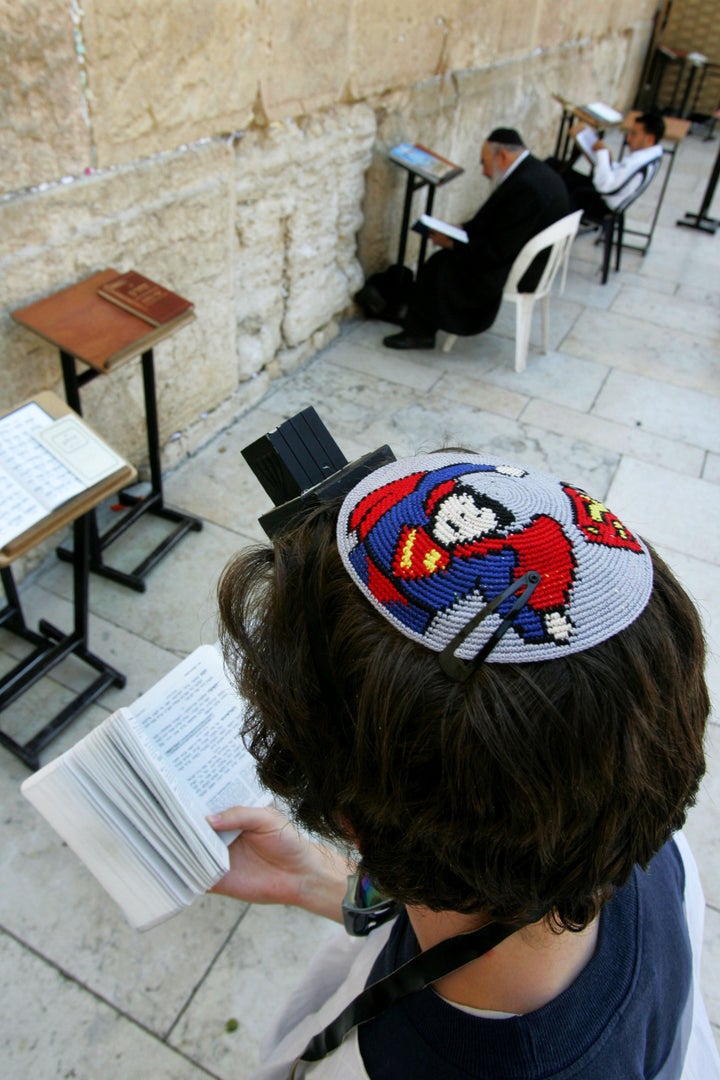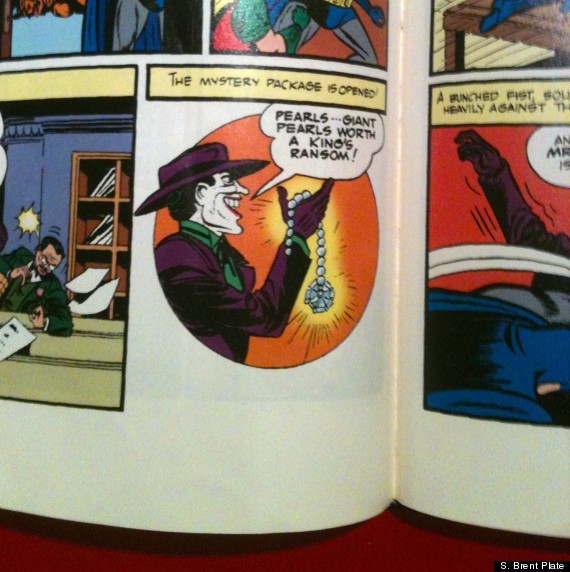
In the August 2002 issue of "The Fantastic Four," the superhero known as The Thing finally came out as Jewish. Many knew this all along, and with a "real" name like Benjamin Jacob Grimm and the fact that he grew up on the Lower East Side of Manhattan the obvious was there. Yet, in this particular Marvel issue, the secular Jew begins to observe. In the story, "Remembrance of Things Past," the impervious stone monster-hero stands above a dying man and fumbles to recite the shema prayer, recalling the words from his younger upbringing. When the dying man survives, he questions Grimm's religion and wonders why he hasn't made it more prominent up until now, to which The Thing responds, "Figure there's enough trouble in this world without people thinkin' Jews are all monsters like me." Fair enough. The man assuages Grimm's guilty inclinations by saying, "What you learned on the street, what you learned at the synagogue -- when you need those things, you can always ... get them back."
Scratch the surface of almost all great comic books and we might find something startling similar: the roots of today's superheroes lie in a particular Jewish culture transplanted from Europe to the United States in the first half of the 20th-century. The creators of Superman, Batman, Captain America, Spider-Man, Incredible Hulk, Fantastic Four, X-Men and many others were all from Jewish families and, as some have argued, infused their characters with Jewish values. Jack Kirby, hailed as the "King of Comics" and creator of many pen-and-ink superheroes, once said that "Underneath all the sophistication of modern comics, all the twists and psychological drama, good triumphs over evil. Those are the things I learned from my parents and from the Bible. It's part of my Jewish heritage."
Yet, names were changed for the sake of assimilation: Kirby was born as Jacob Kurtzberg; Stanley Lieber, creator of Spider-Man, became Stan Lee; Robert Kahn, creator of Batman, became Bob Kane, and so forth. And explicit religious references were generally disregarded. The Thing's 2002 revelation charts in microcosm some of the changes that have taken place in the four decades after his inception. Partly this is a shift in the specifics of Jewish identity in the wake of the Nazi takeover of much of Europe mid-century. But the fact that religious references in general have become more accepted in comics of the past decade or so tells us a good deal about the 21st century's connection between pop culture and religion.
The Rise of the Comic Superhero
Almost as if fulfilling the dying man's words ("you can always ... get them back") a number of books and museum exhibitions have emerged in recent years charting a clear line between the rise of comics and something about the Jewish identities of the young artists who created them. I recently visited the exhibition, bulkily titled "Zap! Pow! Bam! The Superhero: The Golden Age of Comic Books, 1938-1950," at Baltimore's Jewish Museum of Maryland. The late Jerry Robinson, who worked with the comic book industry for many years and who created Batman's sidekick "Robin," set up the exhibition with the William Breman Jewish Heritage Museum in Atlanta in 2004. It has since traveled the United States. The Baltimore version had it confined to one large room, making the already visually complex imagery of comics more scrambled, but the overall effect worked a bit like a page with text and image conjoined in various panels. What the exhibition does well is show the rise of the superhero in comic books, and how that is situated within a specific socio-political-cultural field. This is no comic for comic's sake.
The so-called Golden Age of comics emerges out of the Great Depression and the rise of Hitler and Japanese militarism. From 1940 to 1945, comic book sales tripled. Centered especially around New York, a number of young Jewish artists began to create superheroes in the midst of social fragmentation and uncertainty. The creation story occurs when Jerry Siegel and Joe Shuster wrote and inked Superman as the first issue of Action Comics in June 1938. The next year Bill Finger and Bob Kane published the first appearance of Batman in the series Detective Comics. They were all in their early-mid 20s.
Mythical ties were made implicit: Superman was like Moses, saved from destruction as an infant and sent off to liberate a people. The magic word SHAZAM!, shouted by Billy Batson/Captain Marvel is an acronym of the names Solomon, Hercules, Atlas, Zeus, Achilles, and Mercury, though that is apparently an insider's secret knowledge. And Wonder Woman, for those who looked deeper, came from Paradise Island, among a people devoted to Aphrodite. Beyond the specific, sometimes esoteric connections known only to fanboys and other initiates, there is the longstanding myth of the hero's journey, on which these characters are also based. Heroes have typically been human, and just that. So the need for something more, something super, at this time and place is curious.
Quentin Tarantino's revenge fantasy in "Inglourious Basterds" was nothing new. Comics of the 1940s have Superman, Captain America, Captain Marvel and several others facing down the Nazis, destroying their weapons of war and punching Hitler in the face. And it is the Nazi aggression that spurred many of the superheroes through the Golden Age. While I'm not totally convinced of the connection, Jane Leavey, Director of the Breman Museum writes in the forward to the "Zap! Pow! Bam!" catalog that the superheroes took on the role of tikkun olam, the repairing of the world imbedded in some elements of Jewish tradition. Certainly Batman is doing justice (at least the 1939 Batman was) and fixing what's not right, but it's not clear that this is altogether the same thing as that Hebrew phrase connotes. Regardless, with the comic book, as in real life, religion is in the action.
Beyond Good and Evil in the New Normal
Once the war was over, economic prosperity rose, and America emerged into a new normal as world superpower, the need for the superhero began to diminish. One wall text in the exhibition laments, "The 'common man,' once so in need of a superhero to protect and defend him against urban corruption and the forces of evil, was now living comfortably in a middle-class American suburb."
In the midst of the cultural turmoil, and legitimate fears at the time of the Second World War, the images and narratives of comic books provided clear cut differences between the good guys and bad guys. Sometimes the bad guys were inventions of the artists' studios, sometimes they were based on reality. Regardless, you knew who was who. See here the depiction of the Joker from the 1940s, created by Jerry Robinson.

The early Joker wants what everyone wants, just writ large and obsessive: money, fame, power. His diabolical schemes are all set up to get more money. Heath Ledger's 2008 portrayal of him in Christopher Nolan's "The Dark Knight" is now itself legendary: anarchy, amorality and chaos are the forces of the day. And this deeper unhinging of things drives the good guys beyond good and evil, as happens with Batman. What is a hero good for anymore?
Refinding the Religious in the Comics
On the day I visited Baltimore's Jewish Museum, Rabbi Simcha Weinstein was there promoting his 2006 book, "Up, Up, and Oy Vey! How Jewish History, Culture, and Values Shaped the Comic Book Superhero" (Leviathan Press). The book provides a (sometimes too) straight line between Jews and superheroes. The opening paragraph relates "superpatriachs and supermatriarchs" like Moses, Aaron, Joshua, Ruth and Esther to Superman, Batman and Spider-Man, all using courage and supernatural power to protect and serve. Underneath those flowing capes and latex are archetypes of the mythological sort.
More recently, Harry Brod's "Superman is Jewish? How Comic Book Superheroes Came to Serve Truth, Justice, and the Jewish-American Way" (Free Press 2012) offers a broader, culturally attuned study. Brod, known for his work in masculinity studies, shows not just the Jewish-comic connection, but the ways "The Jewish men who created supermen were men who were themselves seen as not measuring up to the standards of what real men were supposed to be. ... Less-than-real men creating supermen." This has intriguing implications for understanding contemporary culture, and the eroding divisions between male and female, the natural and supernatural. Meanwhile, the secret connections between the Jewish creators and superheroes are now being revealed in an age that no longer believes in clear differences between good and evil.
As we await the messianic Man of Steel in theaters this summer, we might recall the Jewish roots of messiahs, recall again the sacredness of the superhero, and wonder what exactly it is they need to save us from, save ourselves.
